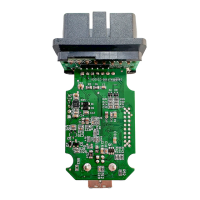LCD-TFT controller (LTDC) RM0090
492/1749 RM0090 Rev 18
16.6 LTDC programming procedure
• Enable the LTDC clock in the RCC register
• Configure the required Pixel clock following the panel datasheet
• Configure the Synchronous timings: VSYNC, HSYNC, Vertical and Horizontal back
porch, active data area and the front porch timings following the panel datasheet as
described in the Section 16.4.1: LTDC Global configuration parameters
• Configure the synchronous signals and clock polarity in the LTDC_GCR register
• If needed, configure the background color in the LTDC_BCCR register
• Configure the needed interrupts in the LTDC_IER and LTDC_LIPCR register
• Configure the Layer1/2 parameters by programming:
– The Layer window horizontal and vertical position in the LTDC_LxWHPCR and
LTDC_WVPCR registers. The layer window must be in the active data area.
– The pixel input format in the LTDC_LxPFCR register
– The color frame buffer start address in the LTDC_LxCFBAR
register
– The line length and pitch of the color frame buffer in the LTDC_LxCFBLR
register
– The number of lines of the color frame buffer in the LTDC_LxCFBLNR
register
– if needed, load the CLUT with the RGB values and its address in the
LTDC_LxCLUTWR register
– If needed, configure the default color and the blending factors respectively in the
LTDC_LxDCCR and LTDC_LxBFCR registers
• Enable Layer1/2 and if needed the CLUT in the LTDC_LxCR register
• If needed, dithering and color keying can be enabled respectively in the LTDC_GCR
and LTDC_LxCKCR registers. It can be also enabled on the fly.
• Reload the shadow registers to active register through the LTDC_SRCR register.
• Enable the LCD-TFT controller in the LTDC_GCR register.
• All layer parameters can be modified on the fly except the CLUT. The new configuration
has to be either reloaded immediately or during vertical blanking period by configuring
the LTDC_SRCR register.
Note: All layer’s registers are shadowed. Once a register is written, it should not be modified again
before the reload has been done. Thus, a new write to the same register will override the
previous configuration if not yet reloaded.

